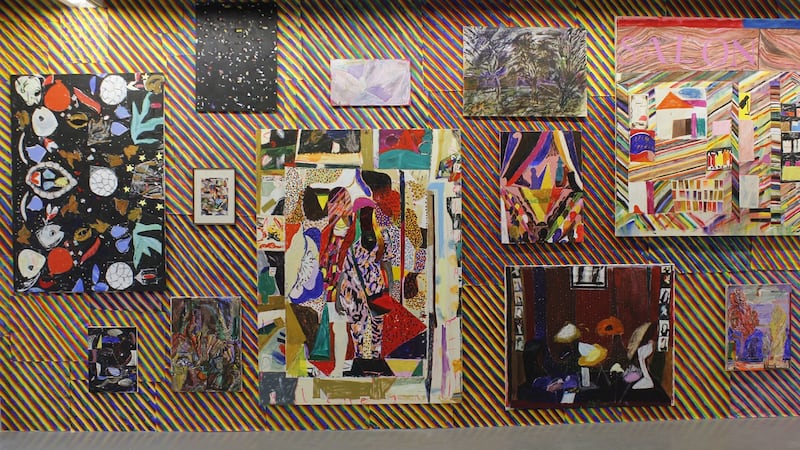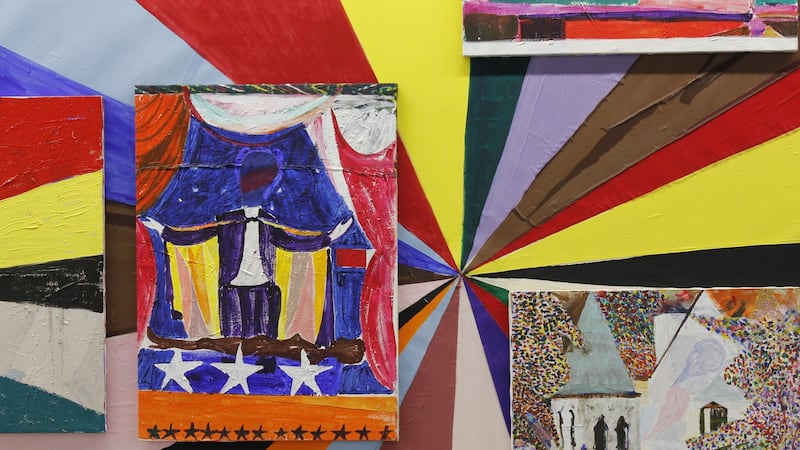The Living and the Dead: Mark Swords
Temple Bar Gallery, Dublin ★★★★★
The title of Mark Swords’s exhibition came from a video interview he saw with the Israeli-born artist Tal R, who grew up and lives in Copenhagen. Tal R’s paintings are about his familiar Copenhagen environment. One day, he notes, a friend explained to him that: “In the city, and that means every city, it’s always the living and the dead that are walking around.” You see the living and sense the dead. Cities are full of leftover fragments and signs, and from time to time you suddenly notice one: an index to a whole underlying layer of past life.
Swords was working towards his Temple Bar show, and he was trying not to pin himself down too much. "I had a number of reference points: Joyce's The Dead, Dylan Thomas's Under Milk Wood, one of Brian Eno's Oblique Strategies that says simply 'Accrete'." Accrete was probably the most relevant hint. Rather than channelling his work into any one source or subject, "I was trying to find a way of saying it's everything." Too often, he feels, exhibitions are proposed and created within strict, predefined parameters, suited to encapsulation in neat explanatory texts. "If I had been restrictive it would have stopped me doing all sorts of things."
He was not restrictive. Originally he thought that the show might consist of one vast tapestry-like composite of multiple paintings sewn together. How to actually do that, technically, stopped him in his tracks. The idea comes through, though, in the general form of the exhibition and in one central piece. The bulk of the work is divided into two monumental composites, occupying opposite, east and west walls of the gallery. The centre is left clear, like a piazza or a plaza, an open civic space. The “everything” he aimed for is the freedom to evoke a whole world.
One wall is life or day, the other death or night. Mediating between them is one large piece incorporating versions of some of the paintings we see on both walls. The central piece can be seen as a study for, or perhaps a guide, to the overall show. Its multiple elements fit roughly together, teeming with imagery, patterns and words. It is fractured and fragmentary. Look closely and there are many optical delights amid the clashes and contrasts.

That holds true for each wall as well. It’s important that neither is a unified tapestry. They challenge and jar. Swords doesn’t say so, but the impact it makes is a good approximation of how one experiences the urban fabric. He draws on specific imagery, from the site of his local bus terminus at a roundabout to the shopfronts, signage, graffiti and glimpses of daily life. In absorbing and processing this nonstop barrage of imagery and sensation he is “being a mirror, reflecting things as they happen”.
Theatricality of life
The theatricality of city life comes across vividly, from the set-design quality of shops and salons to the sense of the performance of identity in the way people conduct and define themselves. Then there is the rough-hewn character of the spaces, cobbled together, makeshift and durable, rich and poor, interiors and exteriors. A city is a composite, an ordered jumble of glitter and grime, of onrushing vitality and a site of abundance to the point of excess. Theatres recur with views of audiences, proscenium arches, stages, and performers, including a magician. There are ghoulish masks for Halloween.
There’s a good chance that on a brief visit you may not see the trees for the wood. The environmental ensemble is visually overwhelming, so much so that it takes time to disentangle the individual compositions from the mass. Swords admits to having mixed feelings about it. Each work has been made as a single, autonomous piece and to band them together against a boldly patterned ground is to sacrifice some of that autonomy. Piece for piece, there are many quite brilliant paintings. A great deal of work has clearly gone into each of them. On the one hand, he is surprised, he says, at how it is still possible to read them individually. On the other, he seems a little conflicted, which is probably a healthy response to the complexity of what he has made. As he says of the paintings, he’s happy that: “I managed to make them by tricking myself into making them.”

Swords, who completed an MFA at NCAD in 2004, won the AIB Art Prize in 2010 and exhibits with the Kevin Kavanagh Gallery, Dublin, is known as a fine colourist who favours a deceptively informal but always exacting aesthetic. He has consistently emphasised the manual nature of making art and has embraced a plethora of materials and techniques. Printed fabric, tapestry, thread, wool, buttons, staples and found objects are all routinely pressed into service. Stitching, stapling, collage and construction are as central as applying paint to canvas, although it seems fair to describe him as being primarily a painter, while allowing that he has ventured into three-dimensional work with great flair and effect. Along with the importance of making, there's also a clear interest in unmaking and a desire to be upfront about the nuts and bolts of how things are put together. The living and the dead is a major achievement for an artist who, as he puts it, is happier to deal with obstacles than simply doing things he's already comfortable with.
- Until June 17, templebargallery.com













